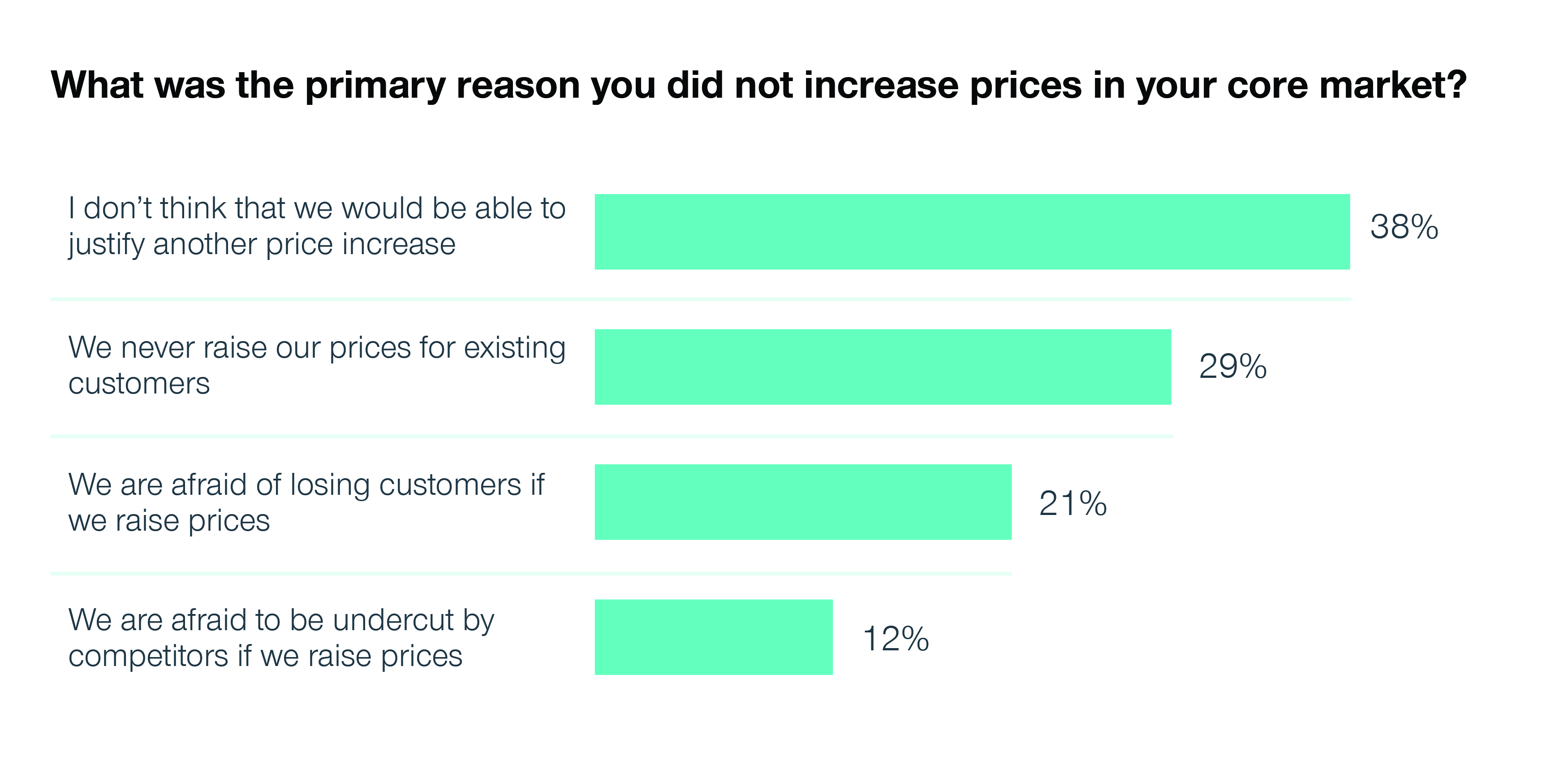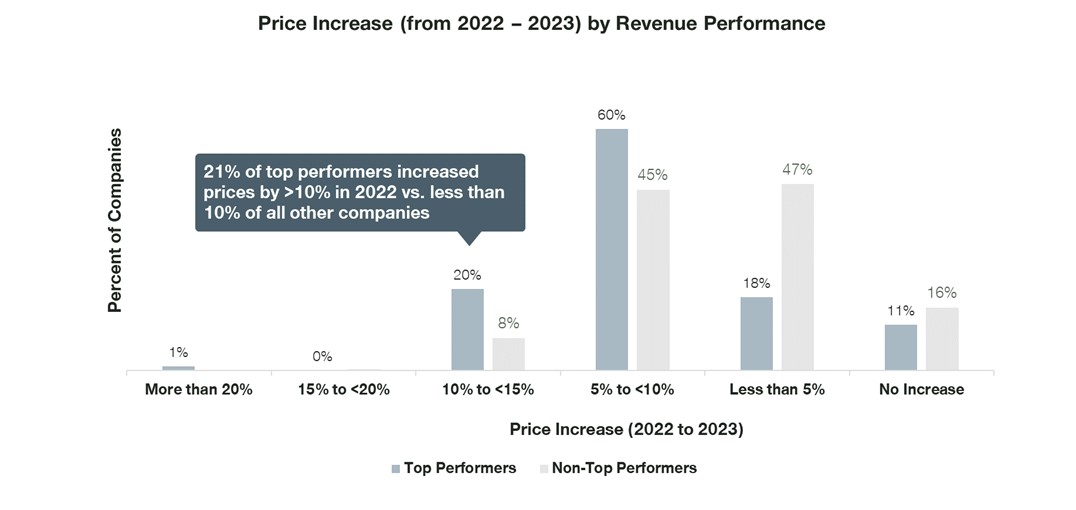In the current economic climate with increased cost of capital and sustained high inflation across global markets, it’s important for your organization to have an effective annual price increase process in place. As we enter the last quarter of 2023, now is the time to start thinking about your next annual price increase.
The problem with most B2B SaaS companies today is that they’ve lost (or never developed) the “muscle” to follow through on increasing prices. We commonly see that companies are afraid to raise prices, fail to include effective price increase clauses, or insufficiently prepare for a diligent annual price increase process.
We surveyed 500 B2B SaaS leaders and found that the best B2B SaaS companies are able to effectively raise prices annually, while maintaining a higher net customer growth than others. What can we learn from these best-performing B2B Saas companies? They have trained their pricing muscle adequately, differentiate their price increase targets, prepare diligently and closely monitor key metrics.
In this article, we will discuss the most common pricing misconceptions and mistakes and share best practices that will help you to successfully implement your next price increases.
Common pricing misconceptions and mistakes
In our Global Software Study we find there are three common mistakes being made in increasing prices.
- Not daring to increase prices: We find that only 28% of B2B SaaS companies raised their prices on all their products last year. 15% of B2B SaaS companies did not increase their prices at all. The most common reasons for not raising price was a lack of confidence. 38% of companies are afraid that they would not be able to justify a price increase; 21% are afraid to lose customers, and 12% are afraid to be undercut by competitors. In addition, almost 30% of these companies report that they never raise their prices for existing customers at all.

- Not including annual price increase clauses in your multi-year contracts: Among the 500 only 35 percent of B2B SaaS companies offering multi-year contracts have included contractual price increases. 70 percent of companies with contractual price increases only increase between 1 and 3 percent per year. Ggven recent inflation rates we believe price increase clauses should be a standard part of a multi-year contract for companies to compensate (at least some of) the cost increases.
- Not differentiating the price increase target across customers: We found that 38 percent of B2B SaaS companies surveyed make the mistake of deploying higher prices evenly across their customer base, not considering profitability, enforceability, or willingness-to-pay. Following this strategy, customers are less likely to accept the higher prices, which heavily limits the potential of the companies’ price increase measures. 55 percent of non-differentiating companies report a price increase of less than 5 percent whereas this share is only 32 percent for companies that did differentiate their price increases.
Best practices from the best-in-class
Contrary to the common fear that raising your prices would lead to excessive volume loss, in our study we foundthat the B2B SaaS companies with the highest net customer growth are able to successfully raise their prices. 90% of this best-in-class selection are able to effectively raise their prices for some or all products. Not only do they raise their prices annually, but they do also do so on a larger share of their product portfolio and are able to realize higher price increases.

Diving deeper into what sets them apart, we see that these B2B SaaS companies have strengthened their pricing muscle through three key actions:
- Configure the levels: Differentiate price increase targets on customer-level and develop account plans for your most important customers
77% of the best-in-class reported differentiating their price increases across customers. Companies that operate in a more transactional SMB environment will need to adopt a rule-based strategy based on indicators of price increase potential. For larger, enterprise-level customers, companies will need to create comprehensive account plans with a well-defined negotiation strategy that includes going-in, target, and walk-away prices. To determine the price increase potential per customer, companies should assess their business situation and client relationship.
- Get prepared: Develop communication materials, clear escalation rules, and a compelling incentive system for your commercial organization.
85% of the best-in-class have prepared typical customer objections and how to respond to these. Developing a compelling value story that clearly outlines why the price increase is necessary and justified will be key. Best-in-class B2B SaaS companies focus on the value they provide and their competitive advantages. Based on these materials, prepare your Sales and Customer Success team with a negotiation training so they are well-equipped for any challenging conversations ahead.
- Monitor success: Provide sufficient management attention, monitor key metrics and be prepared to steer when required.
73% of best-in-class companies are tracking price realizations on a SKU level. Finally, it is crucial to set up structural monitor of KPIs. There must be constant and thorough reporting, impact tracking, and pricing performance reviews. C-suite and upper management involvement is critical to set the tone and prioritize organizational goals. To avoid price erosion, and ensure negotiations are effective, your Sales and Customer Success teams know which concessions they are allowed to make in advance. Lastly, tracking and monitoring will allow you to capture learnings for next price increase rounds so you can strengthen your teams’ pricing “muscle” over time.
Now is the time to train your pricing muscle
With January around the corner, now is the time to train your pricing muscle and start preparing for your next annual price increase. Interested in how we can support you to improve your price increase process and ensure you are well equipped for the coming year? Feel free to contact us.
The authors wish to thank Roos Offerhaus (Manager) and Pepijn van Eerten (Senior Consultant) for their contribution to this article.








